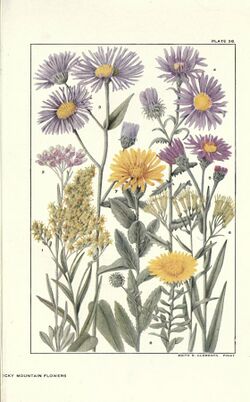Biology:Dieteria bigelovii
| Dieteria bigelovii | |
|---|---|

| |
| Fig. nº 4 | |
| Scientific classification | |
| Kingdom: | Plantae |
| Clade: | Tracheophytes |
| Clade: | Angiosperms |
| Clade: | Eudicots |
| Clade: | Asterids |
| Order: | Asterales |
| Family: | Asteraceae |
| Genus: | Dieteria |
| Species: | D. bigelovii
|
| Binomial name | |
| Dieteria bigelovii (A.Gray) D.R.Morgan & R.L.Hartm.
| |
| Synonyms[2] | |
|
Synonymy
| |
Dieteria bigelovii, also known as Bigelow's tansyaster[3] or sticky aster,[4] is a North American species of plants in the family Asteraceae.
Description
D. bigelovii is a biennial or perennial herb growing to 30–90 centimetres (12–35 inches) in height. The leaves are 5–10 cm (2–4 in) long with sharp teeth.[4] Between August and October, the plant produces several flower heads about 4 cm (1 1⁄2 in) wide.[4] The blue or purple ray florets are female, while the yellow disc florets are bisexual.[5][6] The ray florets close upwards in shade.[4] The fruit is seedlike, with bristles at the tip.[4]
True asters are similar, but usually lack spiny or divided leaves.[4]
Taxonomy
- Dieteria bigelovii var. bigelovii - Colorado, New Mexico, Wyoming
- Dieteria bigelovii var. commixta (Greene) D.R.Morgan & R.L.Hartm. - Wasatch Mountains in Utah
- Dieteria bigelovii var. mucronata (Greene) D.R.Morgan & R.L.Hartm. - Kaibab Plateau in northern Arizona
Distribution and habitat
The species is native to the southwestern United States (Arizona, New Mexico, Utah, Colorado, and Albany County in Wyoming).[7] It can be found in open areas of coniferous forests.[4]
Dieteria bigelovii was evaluated by NatureServe as G4, "apparently secure", in 1993. This means that at a global level it has fairly low risk of extinction or collapse due to an extensive range and/or many populations or occurrences, but with possible cause for some concern as a result of local recent declines, threats, or other factors. It was additionally rated critically imperiled (S1) in Nevada, imperiled (S2) in Wyoming, and vulnerable (S3) in Arizona.[1]
References
- ↑ 1.0 1.1 NatureServe (2023). "Dieteria bigelovii". Arlington, Virginia: NatureServe. https://explorer.natureserve.org/Taxon/ELEMENT_GLOBAL.2.145925/Dieteria_bigelovii.
- ↑ 2.0 2.1 The Plant List Dieteria bigelovii (A.Gray) D.R.Morgan & R.L.Hartm.
- ↑ "Machaeranthera bigelovii var. bigelovii". Natural Resources Conservation Service PLANTS Database. USDA. https://plants.usda.gov/core/profile?symbol=MABIB. Retrieved 21 June 2015.
- ↑ 4.0 4.1 4.2 4.3 4.4 4.5 4.6 Spellenberg, Richard (2001). National Audubon Society Field Guide to North American Wildflowers: Western Region (rev ed.). Knopf. pp. 385. ISBN 978-0-375-40233-3. https://archive.org/details/nationalaudubons00spel/page/385/.
- ↑ 5.0 5.1 Flora of North America, Dieteria bigelovii (A. Gray) D. R. Morgan & R. L. Hartman, Sida. 20: 1394. 2003.
- ↑ Gray, Asa 1857. Reports of explorations and surveys: to ascertain the most practicable and economical route for a railroad from the Mississippi River to the Pacific Ocean, made under the direction of the Secretary of War 4(5): 97
- ↑ Biota of North America Program 2014 county distribution map
Wikidata ☰ Q15577127 entry
 |


